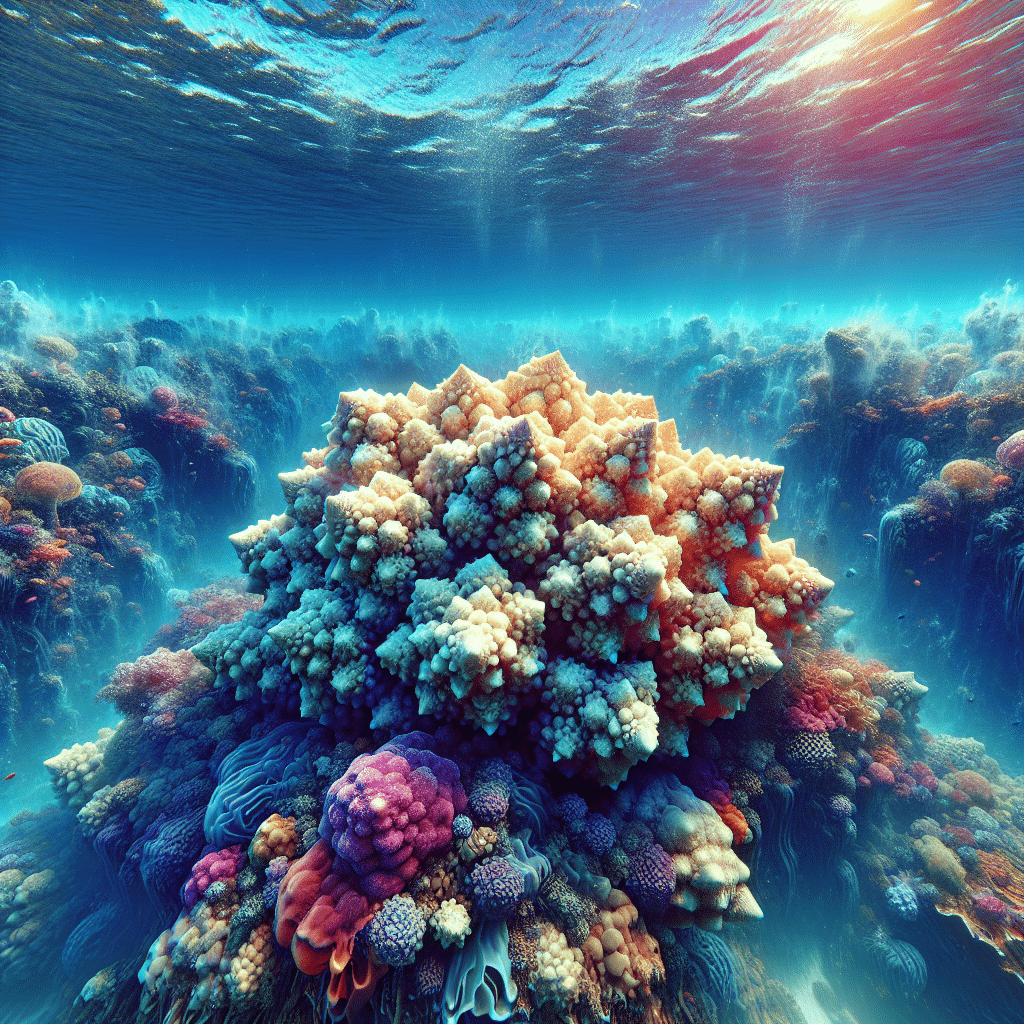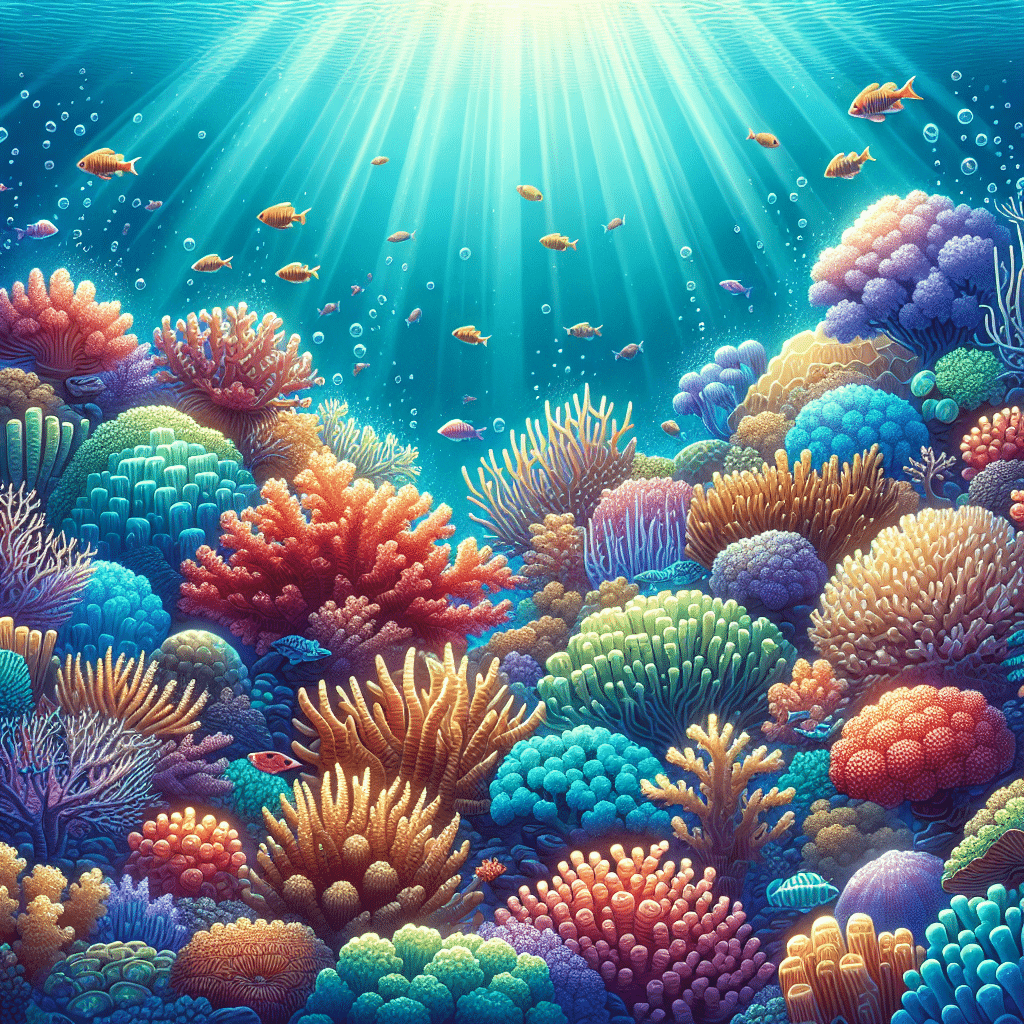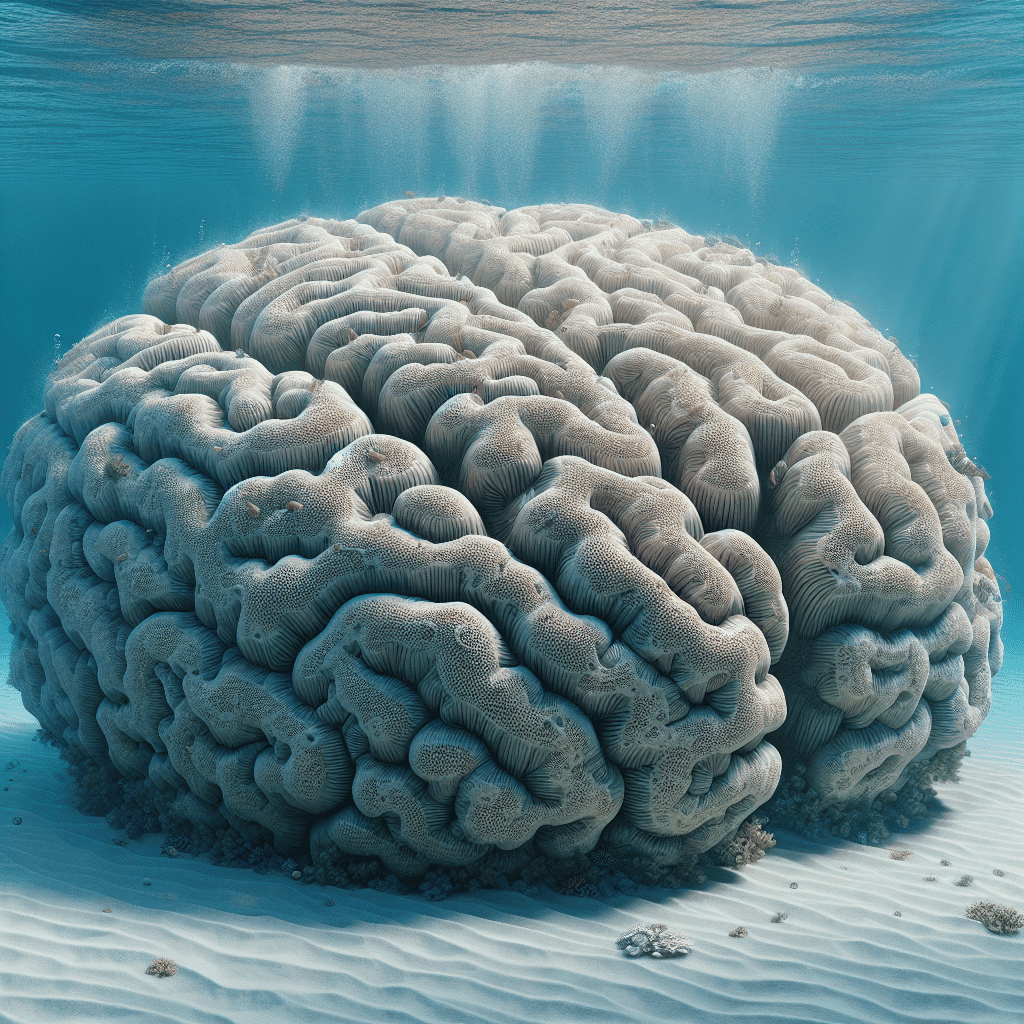Understanding Cauliflower Coral
Habitat and Distribution
Cauliflower coral, scientifically known as Pocillopora meandrina, thrives in coral communities primarily at depths ranging from 1 to 27 meters. I often find it on shallow reefs that are exposed to strong wave action. Its distribution spans across most coral reefs in the Indo-Pacific and eastern Pacific regions, from the Seychelles Islands in the Indian Ocean all the way to the west coast of Central America in the eastern Pacific (NOAA Fisheries). This wide distribution makes cauliflower coral an essential component of many reef ecosystems.
| Region | Depth Range (m) | Typical Environment |
|---|---|---|
| Indo-Pacific | 1 – 27 | Shallow reefs, strong waves |
| Eastern Pacific | 1 – 27 | Shallow reefs, strong waves |
Physical Characteristics
Cauliflower coral colonies typically resemble small upright bushes with branches that radiate from a central point of growth. The branches are flat and covered in small bumps known as verrucae. These colonies are generally cream-colored but can also display shades of green or pink (NOAA Fisheries).
Here’s a quick overview of the physical traits of cauliflower coral:
| Characteristic | Description |
|---|---|
| Colony Shape | Upright bush-like structure |
| Branch Shape | Flattened branches with verrucae |
| Color Variations | Cream, green, or pink |
Understanding the habitat and physical characteristics of cauliflower coral is crucial for anyone looking to incorporate it into their reef tank. Its unique structure and color can add significant beauty to any aquarium, while also supporting the overall health of the marine ecosystem. If you’re interested in exploring other types of corals, check out articles on brain coral or mushroom coral.
Conservation Status of Cauliflower Coral
Endangered Species Act Listing
In 2018, the Center for Biological Diversity took action to protect cauliflower coral by petitioning the National Marine Fisheries Service (NMFS) to have it listed under the Endangered Species Act. This move was prompted by alarming reports of high bleaching prevalence and subsequent mortality caused by unusually high ocean temperatures from 2014 to 2017 in Hawai‘i. These events have put the coral at risk throughout a significant portion of its range in the region (Waikiki Aquarium).
Despite the petition, a 2020 finding concluded that listing was not warranted, which raises concerns about the ongoing threats to cauliflower coral and its habitat. The situation remains critical, as the coral is highly susceptible to heat stress and is facing numerous environmental challenges.
Threats and Stressors
Cauliflower coral faces several threats that contribute to its declining population. Here are some of the main stressors:
| Threats | Description |
|---|---|
| Coral Bleaching | Coral bleaching occurs when coral polyps expel the algae living in their tissues due to stress, leading to loss of color and health. This is primarily caused by elevated water temperatures, which have been a significant issue for cauliflower coral. |
| High Ocean Temperatures | The coral has been particularly affected by extreme ocean temperatures, with a massive bleaching event recorded in West Hawaiʻi and Maui in 2015. During this event, seawater temperatures exceeded 90°F (32°C), resulting in over 75% population loss initially in West Hawai‘i. |
| Pollution | Runoff from coastal areas, including agricultural and urban pollutants, can degrade water quality, adversely affecting coral health. |
| Ocean Acidification | Increased carbon dioxide levels lead to ocean acidification, which can weaken coral structures and hinder their ability to grow and reproduce. |
These stressors continue to jeopardize the health of cauliflower coral, making it essential for hobbyists and conservationists alike to be aware of the challenges it faces. For those interested in the broader world of corals, there are many fascinating species to explore, such as brain coral, hammer coral, and bubble coral.
As I continue to learn about the importance of these corals, it’s clear that their conservation is vital not just for their survival, but for maintaining the health of marine ecosystems overall.
Importance of Cauliflower Coral
Ecosystem Contribution
Cauliflower coral plays a significant role in the health and stability of coral reef ecosystems. Coral reefs are among the most biologically diverse ecosystems on Earth, providing habitat for approximately 25% of the world’s marine life, including over 4,000 fish species (IFAW). These reefs are critical for many marine species, offering shelter, breeding grounds, and food sources.
As a structural component of these reefs, cauliflower coral contributes to the overall diversity and complexity of the habitat. It provides a three-dimensional structure that supports various marine organisms, creating microhabitats for fish and invertebrates. This biodiversity is essential not only for the health of marine ecosystems but also for human activities, including fishing and tourism, which rely on thriving coral habitats.
| Ecosystem Benefits | Details |
|---|---|
| Habitat | Supports 25% of marine life, providing shelter and breeding grounds. |
| Biodiversity | Contributes to the richness of species in coral reefs, supporting a wide range of marine organisms. |
| Coastal Protection | Acts as a natural breakwater, reducing the impact of waves and storms on coastlines. |
Biodiversity Support
The biodiversity associated with cauliflower coral is vital for maintaining the balance of marine ecosystems. Coral reefs, including cauliflower coral, serve as a vital food source for numerous marine creatures. They offer sustenance not just for fish, but also for invertebrates, turtles, and other marine organisms (Discover Wildlife).
Additionally, healthy coral reefs help mitigate climate change by absorbing carbon dioxide from the atmosphere, thereby playing a role in regulating global temperatures. However, the ongoing decline of coral reefs, with 14% disappearing since 2009, poses a significant threat to the marine biodiversity they support. The Intergovernmental Panel on Climate Change (IPCC) projects that with rising global temperatures, between 70% and 90% of coral reefs could vanish if temperatures increase by just 1.5°C (IFAW).
Supporting the health of cauliflower coral not only benefits marine life but also contributes to a balanced ecosystem that is crucial for the well-being of our planet. For those of us who maintain a reef tank, understanding the importance of coral species like cauliflower coral is essential for fostering a vibrant and diverse aquatic environment.
Unique Features of Cauliflower Coral
Cauliflower coral, scientifically known as Pocillopora damicornis, has some fascinating characteristics that make it unique among coral species. From its immune system adaptations to its reproductive strategies, there’s a lot to appreciate about this coral.
Immune System Adaptations
One standout feature of cauliflower coral is its impressive immune system. This coral has evolved heightened immunity to cope with stresses from climate change, such as ocean acidification. This resilience is linked to a unique genome that enhances its immune function (Discover Wildlife).
The complex immune system of cauliflower coral allows it to thrive in various environments, making it a significant species for researchers studying how corals respond to environmental stresses. Given that coral reefs, including cauliflower coral, play a vital role in ocean biodiversity and provide essential habitats and food sources for marine life, understanding its immune adaptations is crucial.
Reproduction and Spawning
Reproduction in cauliflower coral is quite intriguing. These corals typically spawn in the spring, with peak broadcast spawning usually occurring in May. Interestingly, lunar cycles and tidal changes trigger these spawning events, prompting cauliflower corals to release their gametes simultaneously with nearby corals.
This synchronized spawning increases the chances of successful fertilization and contributes to the genetic diversity of coral populations. Following significant bleaching events, where over 75% of the population was lost in certain areas during a heat stress event, these corals have shown a gradual recovery, aided by these reproductive cycles and slow regrowth (Wild Hawaii).
Understanding these unique features helps me appreciate the resilience and adaptability of cauliflower coral, and it’s essential for anyone interested in caring for corals in a reef tank. For more insights into coral species, check out our articles on brain coral, black coral, and mushroom coral.
Care and Maintenance of Cauliflower Coral
Caring for cauliflower coral in my reef tank has been an enjoyable challenge. These beautiful corals not only add color but also contribute significantly to the aquarium ecosystem. Here’s what I’ve learned about their ideal conditions and feeding requirements.
Ideal Reef Conditions
Cauliflower coral thrives in specific conditions that mimic its natural habitat. Here are the ideal parameters I maintain in my tank:
| Parameter | Ideal Range |
|---|---|
| Water Temperature | 74°F – 82°F (23°C – 28°C) |
| pH Level | 8.1 – 8.4 |
| Salinity | 1.023 – 1.025 g/cm³ |
| Lighting | Moderate to high intensity (LED or T5) |
Cauliflower coral is commonly found at depths of less than 10 feet (3 m) but can go deeper, so I ensure that my lighting setup mimics natural sunlight exposure. They prefer clear waters, so good water quality is essential. Regular water changes and using high-quality filtration help maintain optimal conditions. For additional insights on coral care, check out our article on corals.
Feeding and Nutrition
Feeding cauliflower coral can be quite fascinating. As carnivores, they use their tentacles to capture small planktonic animals and have special stinging cells to immobilize their prey. However, they also rely on a symbiotic relationship with single-celled algae called zooxanthellae, which live within their tissues. These algae perform photosynthesis, generating energy-rich compounds that benefit both the coral and themselves (Waikiki Aquarium).
For optimal health, I offer a variety of foods, including:
- Plankton: Small live or frozen plankton is a great choice.
- Coral Foods: Specialized coral foods are rich in nutrients and ideal for feeding.
- Liquid Foods: Liquid feeding solutions can help provide essential nutrients.
I feed my cauliflower coral a couple of times a week, ensuring that any uneaten food is removed to prevent water quality issues. Incorporating these feeding practices has helped my coral flourish. If you’re interested in exploring more coral types, you can check out mushroom coral or brain coral for more care tips and insights.
Interactions with Other Species
Coral Reef Ecosystem
Coral reefs are fascinating ecosystems that support a diverse range of marine life. They provide a habitat for about 25% of the world’s marine life, including over 4,000 fish species, invertebrates, turtles, and various algae (IFAW). Cauliflower coral, like other corals, plays a vital role in maintaining the health of these ecosystems.
These reefs act as natural breakwaters, reducing the impact of waves and storms on coastlines. They also help mitigate climate change by absorbing carbon dioxide from the atmosphere. The interconnectedness of species within the reef means that the health of cauliflower coral directly influences the entire coral reef ecosystem.
| Feature | Description |
|---|---|
| Habitat Diversity | Supports 25% of marine life |
| Fish Species | Over 4,000 species |
| Ecosystem Services | Natural breakwaters, carbon absorption |
Marine Life Associations
Cauliflower coral not only serves as a habitat but also as a vital food source for various marine creatures. Invertebrates, fish, and other reef dwellers rely on corals for shelter and nutrition. The symbiotic relationships formed within the reef help enhance biodiversity, providing a balanced environment for all species involved.
For instance, certain fish species may seek refuge within the nooks and crannies of cauliflower coral, while simultaneously helping to keep the coral clean by consuming algae and detritus. This mutualistic relationship promotes the overall health of the reef.
In summary, interactions within the coral reef ecosystem, especially involving cauliflower coral, are crucial for sustaining marine biodiversity. Understanding these relationships can help me as a fish tank hobbyist create a more balanced and thriving environment in my own reef tank. For more information on different types of corals, check out our articles on brain coral, mushroom coral, and staghorn coral.
Challenges Faced by Cauliflower Coral
Cauliflower coral, like many corals, faces a number of challenges that threaten its survival. Understanding these challenges helps me take better care of my reef tank and ensures the health of my corals.
Bleaching Events
One of the most significant threats to cauliflower coral is coral bleaching. This phenomenon occurs when coral polyps expel the algae living within their tissues, which are crucial for their health and color. Factors contributing to bleaching include temperature fluctuations, bacterial infections, extreme tides, and pollutants. Notably, in 2016, between 29 and 50 percent of the Great Barrier Reef experienced severe bleaching.
Cauliflower coral is particularly vulnerable to heat stress. In 2015, a massive bleaching event in West Hawaiʻi and Maui occurred when surface seawater temperatures exceeded 90°F (32°C). During this event, over 75% of the cauliflower coral population was lost initially in West Hawaiʻi, and it has continued to decline slowly since then. While there are signs of recovery through spawning events and gradual regrowth, the impact of such events is devastating for the species.
Ocean Temperature Sensitivity
The sensitivity of cauliflower coral to ocean temperatures is a critical concern. It has been highlighted that the species is at risk due to high bleaching prevalence and mortality caused by abnormally high ocean temperatures between 2014 and 2017 in Hawai‘i. The Center for Biological Diversity even petitioned for cauliflower coral to be listed under the Endangered Species Act due to these threats.
Maintaining stable and appropriate water temperatures in my reef tank is essential to support the health of my corals. Monitoring water quality and temperature can help mitigate the stressors that lead to bleaching, ensuring that my cauliflower coral thrives within the artificial environment.
By understanding these challenges, I can implement better care strategies for my reef tank, fostering a healthier ecosystem for my corals and minimizing their exposure to stressors. For more information about the care of different coral species, visit our sections on brain coral, mushroom coral, and torch coral.
Recovery Efforts for Cauliflower Coral
Restoration Projects
I’ve been following various restoration projects aimed at helping cauliflower coral recover from the significant bleaching events it faced, particularly in Hawai‘i. After the devastating bleaching incident in 2015, when over 75% of the cauliflower coral population was lost in West Hawai‘i, scientists and conservationists began implementing targeted efforts to aid in recovery (Wild Hawaii).
These projects often involve:
- Coral Spawning Events: Encouraging natural spawning events to increase population numbers and genetic diversity.
- Fragmentation and Transplanting: Cutting healthy coral fragments and transplanting them to degraded areas to promote regrowth.
- Monitoring and Research: Keeping an eye on coral health and the effectiveness of restoration techniques through ongoing research efforts.
Many of these initiatives are powered by community involvement, which is something I always find inspiring. Engaging local divers and reef enthusiasts helps raise awareness and support for these critical efforts.
Future Conservation Strategies
Looking ahead, I believe that effective conservation strategies are vital for the long-term survival of cauliflower coral and other coral species. Here are some strategies that I think could make a real difference:
- Enhanced Monitoring: Establishing more robust monitoring programs to track temperature changes and coral health can help identify areas at risk before severe bleaching occurs.
- Public Awareness Campaigns: Educating the public about the importance of coral reefs and how to protect them can foster a sense of stewardship in local communities.
- Reducing Runoff and Pollution: Working to minimize coastal runoff and pollution will help improve water quality, making it easier for corals to thrive.
- Climate Change Mitigation: Supporting initiatives aimed at reducing greenhouse gas emissions is crucial, as rising ocean temperatures pose a significant threat to coral ecosystems globally.
Reef tank hobbyists like myself can also contribute by ensuring that our own tanks reflect the natural conditions of these corals, including maintaining proper lighting, water quality, and feeding practices. For those interested in keeping cauliflower coral or similar types, I recommend checking out our articles on corals and specific species like brain coral or torch coral for more information on care and maintenance.



